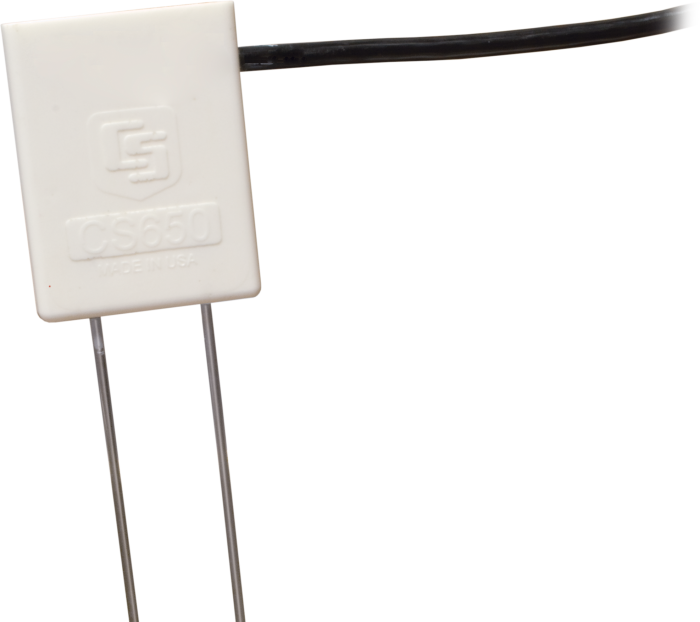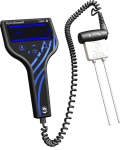
Resumen
El CS655 es un sensor inteligente multiparamétrico que usa innovadoras técnicas para monitorizar el contenido de agua volumétrico, conductividad eléctrica y temperatura del suelo. La señal de salida es digital SDI-12, compatible con la mayoría de nuestros dataloggers. Las varillas son más cortas que las del CS650.
Leer másVentajas y características
- Un mayor volumen de la muestra reduce el error
- Medida corregida para efectos de la textura del suelo y conductividad eléctrica
- Estima el contenido de agua del suelo para una amplia gama de suelos minerales
- Sensor versátil—mide la permitividad dieléctrica, conductividad eléctrica (EC), y temperatura del suelo
Imágenes

Productos similares
Descripción detallada
The CS655 consists of two 12-cm-long stainless steel rods connected to a printed circuit board. The circuit board is encapsulated in epoxy and a shielded cable is attached to the circuit board for data logger connection.
The CS655 measures propagation time, signal attenuation, and temperature. Dielectric permittivity, volumetric water content, and bulk electrical conductivity are then derived from these raw values.
Measured signal attenuation is used to correct for the loss effect on reflection detection and thus propagation time measurement. This loss-effect correction allows accurate water content measurements in soils with bulk EC ≤8 dS m-1 without performing a soil-specific calibration.
Soil bulk electrical conductivity is also calculated from the attenuation measurement. A thermistor in thermal contact with a probe rod near the epoxy surface measures temperature. Horizontal installation of the sensor provides accurate soil temperature measurement at the same depth as the water content. Temperature measurement in other orientations will be that of the region near the rod entrance into the epoxy body.
Especificaciones
| Measurements Made | Soil electrical conductivity (EC), relative dielectric permittivity, volumetric water content (VWC), soil temperature |
| Required Equipment | Measurement system |
| Soil Suitability | Short rods are easy to install in hard soil. Suitable for soils with higher electrical conductivity. |
| Rods | Not replaceable |
| Sensors | Not interchangeable |
| Sensing Volume | 3600 cm3 (~7.5 cm radius around each probe rod and 4.5 cm beyond the end of the rods) |
| Electromagnetic | CE compliant (Meets EN61326 requirements for protection against electrostatic discharge and surge.) |
| Operating Temperature Range | -50° to +70°C |
| Sensor Output | SDI-12; serial RS-232 |
| Warm-up Time | 3 s |
| Measurement Time | 3 ms to measure; 600 ms to complete SDI-12 command |
| Power Supply Requirements | 6 to 18 Vdc (Must be able to supply 45 mA @ 12 Vdc.) |
| Maximum Cable Length | 610 m (2000 ft) combined length for up to 25 sensors connected to the same data logger control port |
| Rod Spacing | 32 mm (1.3 in.) |
| Ingress Protection Rating | IP68 |
| Rod Diameter | 3.2 mm (0.13 in.) |
| Rod Length | 120 mm (4.7 in.) |
| Probe Head Dimensions | 85 x 63 x 18 mm (3.3 x 2.5 x 0.7 in.) |
| Cable Weight | 35 g per m (0.38 oz per ft) |
| Probe Weight | 240 g (8.5 oz) without cable |
Current Drain |
|
| Active (3 ms) |
|
| Quiescent | 135 µA typical (@ 12 Vdc) |
Electrical Conductivity |
|
| Range for Solution EC | 0 to 8 dS/m |
| Range for Bulk EC | 0 to 8 dS/m |
| Accuracy | ±(5% of reading + 0.05 dS/m) |
| Precision | 0.5% of BEC |
Relative Dielectric Permittivity |
|
| Range | 1 to 81 |
| Accuracy |
|
| Precision | < 0.02 |
Volumetric Water Content |
|
| Range | 0 to 100% (with M4 command) |
| Water Content Accuracy |
|
| Precision | < 0.05% |
Soil Temperature |
|
| Range | -50° to +70°C |
| Resolution | 0.001°C |
| Accuracy |
|
| Precision | ±0.02°C |
Compatibilidad
Nota: lo siguiente muestra información de compatibilidad notable. No es una lista de todos los productos compatibles.
Dataloggers
| Producto | Compatible | Nota |
|---|---|---|
| CR1000 (retired) | ||
| CR1000X | ||
| CR300 | ||
| CR3000 (retired) | ||
| CR310 | ||
| CR350 | ||
| CR6 | ||
| CR800 (retired) | ||
| CR850 (retired) |
Información de compatibilidad adicional
RF Considerations
External RF Sources
External RF sources can affect the probe’s operation. Therefore, the probe should be located away from significant sources of RF such as ac power lines and motors.
Interprobe Interference
Multiple CS655 probes can be installed within 4 inches of each other when using the standard data logger SDI-12 “M” command. The SDI-12 “M” command allows only one probe to be enabled at a time.
Optional Installation Tool
CS650G Rod Insertion Guide Tool
The CS650G makes inserting soil-water sensors easier in dense or rocky soils. This tool can be hammered into the soil with force that might damage the sensor if the CS650G was not used. It makes pilot holes into which the rods of the sensors can then be inserted.
Documentos
Folletos producto
Documentos técnicos
Casos de aplicación
Preguntas frecuentes
Número de FAQs relacionadas con CS655: 55
Expandir todoDesplegar todo
-
No. The equation used to determine volumetric water content in the firmware for the CS650 and the CS655 is the Topp et al. (1980) equation, which works for a wide range of mineral soils but not for organic soils. In organic soils, the standard equations in the firmware will overestimate water content.
When using a CS650 or a CS655 in organic soil, it is best to perform a soil-specific calibration. For details on performing a soil-specific calibration, refer to “The Water Content Reflectometer Method for Measuring Volumetric Water Content” section in the CS650/CS655 manual. A linear or quadratic equation that relates period average to volumetric water content will work well.
-
Modifications to the CS650 or CS655, including shortening the cable, will void the warranty. However, shortening the cable will not affect the sensor’s performance. If a decision is made to shorten the cable, care should be taken to avoid damaging the cable jacket and exposing bare wire except at the ends that connect to the data logger or multiplexer terminals.
-
The CS650-series sensors have the same rugged epoxy and stainless-steel rods that have been used for water content reflectometers since the CS615-L model was introduced in 1995. There are CS615-L and CS616 sensors in many locations that have been in continuous use for more than ten years with no reported problems. If a CS650 or CS655 remains undamaged by external forces such as lightning, harsh chemicals, or animal actions, the sensor is expected to continue working for decades.
-
The bulk electrical conductivity (EC) measurement is made along the sensor rods, and it is an average reading of EC over that distance at whatever depth the rods are placed.
-
Probably not. The principle that makes these sensors work is that liquid water has a dielectric permittivity of close to 80, while soil solid particles have a dielectric permittivity of approximately 3 to 6. Because the permittivity of water is over an order of magnitude higher than that of soil solids, water content has a significant impact on the overall bulk dielectric permittivity of the soil. When the soil becomes very dry, that impact is minimized, and it becomes difficult for the sensor to detect small amounts of water. In air dry soil, there is residual water that does not respond to an electric field in the same way as it does when there is enough water to flow among soil pores. Residual water content can range from approximately 0.03 in coarse soils to approximately 0.25 in clay. In the natural environment, water contents below 0.05 indicate that the soil is as dry as it is likely to get. Very small changes in water content will likely cause a change in the sensor period average and permittivity readings, but, to interpret those changes, a very careful calibration using temperature compensation would need to be performed.
-
No. The abrupt permittivity change at the interface of air and saturated soil causes a different period average response than would occur with the more gradual permittivity change found when the sensor rods are completely inserted in the soil.
For example, if a CS650 or a CS655 was inserted halfway into a saturated soil with a volumetric water content of 0.4, the sensor would provide a different period average and permittivity reading than if the probe was fully inserted into the same soil when it had a volumetric water content of 0.2.
-
The CS650 and CS655 are warranted by Campbell Scientific to be free from defects in materials and workmanship under normal use and service for 12 months from the date of shipment. For further details, see the “Warranty” section of the CS650/CS655 manual.
-
Campbell Scientific does not recommend using the CS650 or the CS655 to measure water content in compost. A compost pile is a very hostile environment for making dielectric measurements with soil water content sensors. All of the following combine to make it very difficult to determine a calibration function: high temperature, high and varying electrical conductivity, high organic matter content, heterogeneity of the material in the pile, changing particle size, and changing bulk density. The temperature and electrical conductivity values reported by the CS650 or CS655 may give some useful information about processes occurring in the compost pile, but these sensors will not be able to give useful readings for water content.
-
No. The principle that makes these sensors work is that liquid water has a dielectric permittivity of close to 80, while soil solid particles have a dielectric permittivity of approximately 3 to 6. Gasoline and other hydrocarbons have dielectric permittivities in the same range as soil particles, which essentially make them invisible to the CS650 and the CS655.
-
The CWS655 is a wireless sensor with measurement electronics, radio, and power supply all integrated in a single device. The CWS655, however, requires the use of a CWB100 base station radio connected to a datalogger. Only the rods of the CWS655 should be buried in the soil; burying the body of the CWS655 will prevent the sensor from communicating with the CWB100.
The CS655 is a cabled multiparameter smart sensor that sends data by RS-232 serial or SDI-12 communication through a direct connection to a datalogger. The CS655 is suitable for burial at any depth.
Casos de aplicación
The Utah Geological Survey, supported by the Utah Division of Water Rights, has constructed a......leer más
International partnerships for sustainable innovations Improved water use in agriculture is essential to successfully adapt to......leer más
This case study discusses the integration of CPEC310 and AP200 systems to explore the theories......leer más














